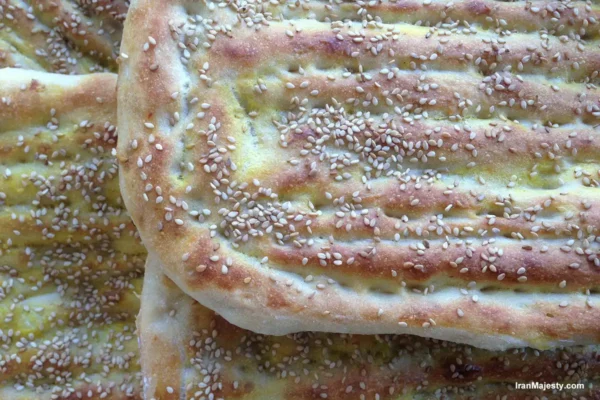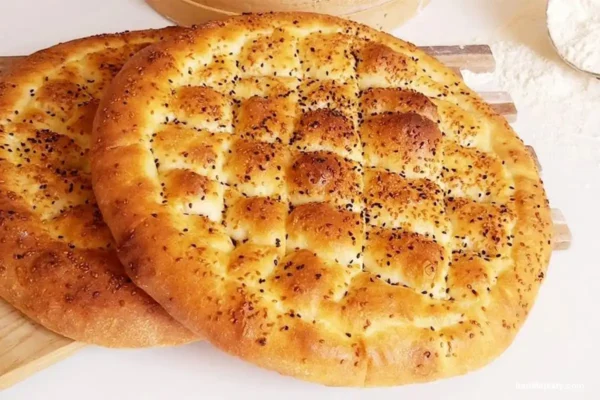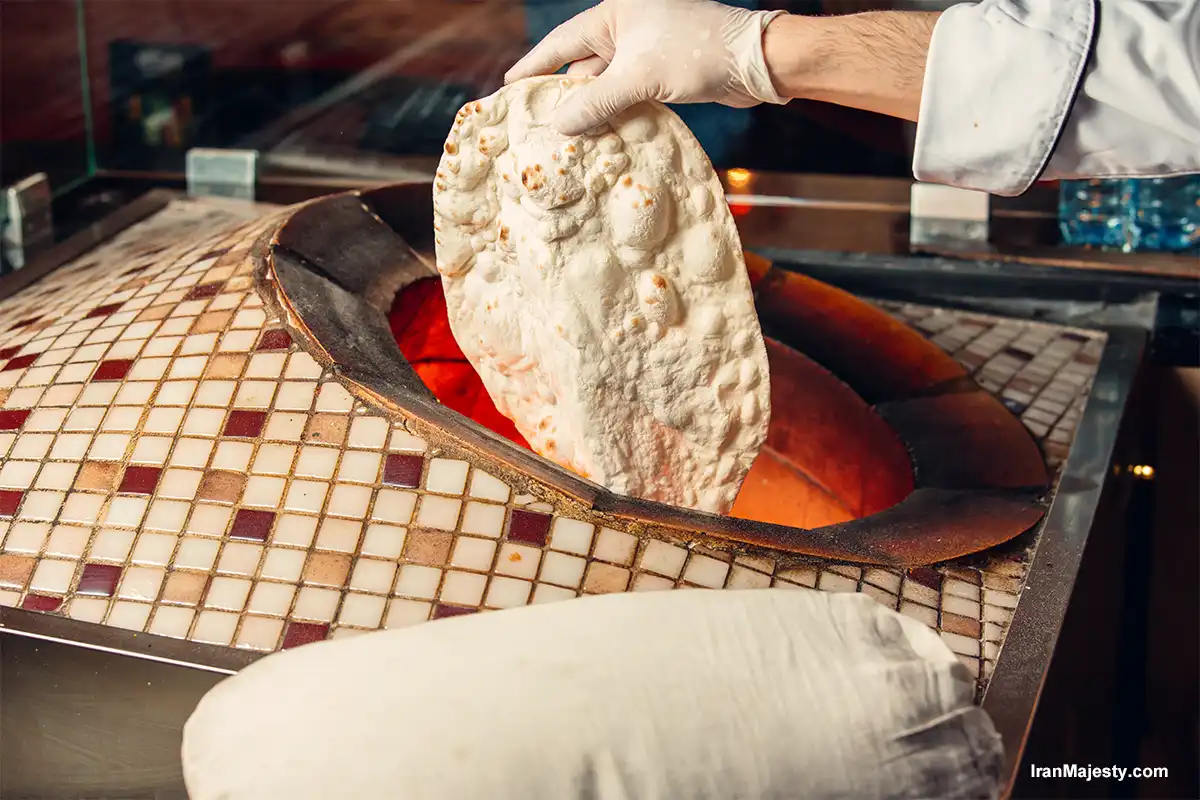While visiting Tehran, I stumbled upon a bustling local bakery during a crisp autumn morning. The air was filled with the warm, inviting aroma of freshly baked bread. Inside, bakers skillfully stretched dough, flipping it onto the hot walls of a traditional tanoor oven. A friendly local explained the names and nuances of the various breads—each more fascinating than the last. I sampled sangak, a rustic flatbread baked on hot stones, and marveled at its unique texture. This experience introduced me to the profound cultural significance of bread in Iranian cuisine, where it is more than just food—it is tradition, community, and history woven together.
Overview of Iranian Breads: A Culinary Legacy
Bread, or nan, holds a special place in Iranian cuisine. It is a staple food found on every dining table, from humble homes to lavish feasts. Iranian breads are renowned for their variety, taste, and cultural heritage. They reflect the nation’s agricultural roots and its rich culinary diversity. With distinct regional styles, Iranian breads symbolize hospitality, artistry, and the importance of food in bringing people together.
Types of Traditional Iranian Breads
Iranian breads are diverse in taste, texture, and preparation methods. Most of these breads are integral to Iranian meals, often used for breakfast or eaten alongside a variety of dishes. Below are some of the most popular types:
Sangak: The Rustic Flatbread
Sangak is a whole wheat flatbread baked on hot river stones, giving it a distinctive texture and earthy flavor. Traditionally served with kebabs or cheese, it’s a favorite in Iranian households.
“Here’s a fantastic video on The Rich Tradition of Iranian Breads by Anthony Rahayel. I’m embedding it to provide you with additional context, with full appreciation for the creator’s efforts.

Barbari: The Thick Crust Delight
Known for its thick, chewy texture, barbari is brushed with a glaze of flour and water before baking, creating a golden crust. It is often paired with butter and jam for breakfast.

Lavash: The Thin and Versatile Staple
Lavash is a thin, soft bread that is easy to roll and ideal for wraps. Its simple ingredients make it a staple for everyday meals.
Taftoon: The Aromatic Bread
Baked in a clay oven, taftoon has a slightly thicker texture than lavash and often includes a hint of saffron or cardamom for added flavor.
Fancy Iranian Breads: Sweet and Indulgent Treats
In addition to the rustic and everyday breads of Iran, there are several fancy breads that stand out for their sweet flavors and unique textures. These breads are often enjoyed on special occasions or as delightful accompaniments to tea. Let’s explore three of these cherished varieties.
Bolki Bread: The Soft and Buttery Bread
Bolki bread is a soft, slightly sweet bread enriched with milk and butter, giving it a tender crumb and delicate flavor. Often shaped into small rolls or braided loaves, Bolki bread is commonly served at breakfast or with afternoon tea. Its light texture and subtle sweetness make it an inviting choice for anyone seeking a more refined bread experience.
Ghandi Bread: The Sugar-Infused Delight
Ghandi bread, named after the Persian word ghand meaning sugar, is a semi-sweet bread often sprinkled with sugar or sesame seeds. This bread has a slightly crisp crust and a soft, fluffy interior. It is ideal for festive gatherings or as a dessert accompaniment. Pairing Ghandi bread with tea creates a perfect harmony of flavors.
Shirmal Bread: The Saffron-Scented Luxury
Shirmal, meaning “milk-rubbed,” is a golden-hued bread made with milk, sugar, and often saffron. Its distinctive aroma and slightly sweet flavor make it a luxurious choice for celebrations and special occasions. Shirmal is often adorned with a sprinkling of poppy or sesame seeds, adding to its visual and culinary appeal. It’s a favorite treat during Nowruz or family gatherings.

Adding Fancy Breads to the Iranian Bread Experience
Iranian fancy breads such as Bolki, Ghandi, and Shirmal add a layer of indulgence to the country’s already diverse bread repertoire. These breads showcase the creativity and cultural richness of Iranian baking, reflecting the nation’s love for sweet and aromatic flavors. Whether you’re enjoying a warm slice of Shirmal with tea or savoring the buttery softness of Bolki, these fancy breads provide a taste of celebration and comfort in every bite.
The Baking Process: A Blend of Tradition and Skill
Iranian bread-making is an art that requires precision, patience, and experience. Traditional methods often involve clay ovens, wooden paddles, and natural ingredients. The dough preparation varies depending on the bread type, with techniques passed down through generations. Watching a baker at work is witnessing a blend of skill and cultural heritage in action.
The Role of Bread in Iranian Culture
Bread in Iran symbolizes sustenance and is deeply ingrained in daily life. It is not merely a side dish but a central component of most meals. Sharing bread is an act of hospitality, and traditional baking methods reflect the communal spirit of Iranian society.
Where to Experience the Best Iranian Breads
For travelers, visiting a local bakery in Iran is a must. Cities like Tehran, Isfahan, and Shiraz boast bakeries where you can watch traditional methods and savor freshly baked bread. These bakeries are often gathering places where locals come together, adding a social dimension to the experience.
“Here’s a wonderful video by Nardoon that dives deeper into The Rich Tradition of Iranian Breads: Savoring the Art of Iranian Baking. I’ve embedded it here to provide you with additional insights and visual understanding—credit goes to the creator for their excellent work.”

Conclusion: The Enduring Appeal of Iranian Breads
Iranian breads are more than a culinary delight—they are a window into the country’s rich cultural and historical tapestry. From the rustic simplicity of sangak to the sweet indulgence of Shirmal, each bread tells a story of tradition, innovation, and connection. Exploring these breads offers not only a taste of Iran’s heritage but also an appreciation for the artistry and dedication behind every loaf. For food enthusiasts and travelers alike, Iranian breads promise an unforgettable experience that goes beyond the obvious, inviting you to savor the essence of a timeless culinary tradition.


0 Comments